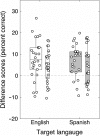Code-Switching in Highly Proficient Spanish/English Bilingual Adults: Impact on Masked Word Recognition
- PMID: 30076419
- PMCID: PMC6195050
- DOI: 10.1044/2018_JSLHR-H-17-0399
Code-Switching in Highly Proficient Spanish/English Bilingual Adults: Impact on Masked Word Recognition
Abstract
Purpose: The purpose of this study was to evaluate the impact of code-switching on Spanish/English bilingual listeners' speech recognition of English and Spanish words in the presence of competing speech-shaped noise.
Method: Participants were Spanish/English bilingual adults (N = 27) who were highly proficient in both languages. Target stimuli were English and Spanish words presented in speech-shaped noise at a -14-dB signal-to-noise ratio. There were 4 target conditions: (a) English only, (b) Spanish only, (c) mixed English, and (d) mixed Spanish. In the mixed-English condition, 75% of the words were in English, whereas 25% of the words were in Spanish. The percentages were reversed in the mixed-Spanish condition.
Results: Accuracy was poorer for the majority (75%) and minority (25%) languages in both mixed-language conditions compared with the corresponding single-language conditions. Results of a follow-up experiment suggest that this finding cannot be explained in terms of an increase in the number of possible response alternatives for each picture in the mixed-language condition relative to the single-language condition.
Conclusions: Results suggest a cost of language mixing on speech perception when bilingual listeners alternate between languages in noisy environments. In addition, the cost of code-switching on speech recognition in noise was similar for both languages in this group of highly proficient Spanish/English bilingual speakers. Differences in response-set size could not account for the poorer results in the mixed-language conditions.
Figures



References
-
- Abutalebi J., Brambati S., Annoni J. M., Moro A., Cappa S., & Perani D. (2007). The neural cost of the auditory perception of language switches: An event-related functional magnetic resonance imaging study in bilinguals. The Journal of Neuroscience, 27, 13762–13769. https://doi.org/10.1523/JNEUROSCI.3294-07.2007 - PMC - PubMed
-
- Alvarez R. P., Holcomb P. J., & Grainger J. (2003). Accessing word meaning in two languages: An event-related brain potential study of beginning bilinguals. Brain and Language, 87, 290–304. https://doi.org/10.1016/S0093-934X(03)00108-1 - PubMed
-
- Barker G. (1947). Social functions of language in a Mexican-American community. Acta Americana, 5, 185–202.
-
- Birdsong D., Gertken L. M., & Amengual M. (2012). Bilingual language profile: An easy-to-use instrument to assess bilingualism. Austin, TX: COERLL, University of Texas; Retrieved from https://sites.la.utexas.edu/bilingual/
-
- Bench J., Kowal A., & Bamford J. (1979). The BKB (Bamford–Kowal–Bench) sentence lists for partially-hearing children. British Journal of Audiology, 13, 108–112. - PubMed
Publication types
MeSH terms
Grants and funding
LinkOut - more resources
Full Text Sources
Other Literature Sources
Miscellaneous

